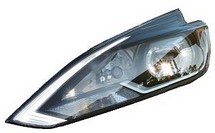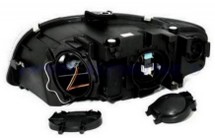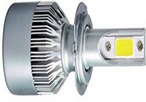Headligth
Applications > Automotive > E&E
Headlights | ||
| One of the most important parts in a car is the headlight to forward. A typical automotive headlight has a series of components that have one or more functions. It has a body called a PP shell with talc or fiberglass, a seal to prevent the areas of the lens from fogging after a while, a bevel to reflect light and a lens. The most notable part of the headlights is the lens. The lens is probably one of the most important components of the headlight because it has several important functions. |  | |
| Housing components | ||
Body and cover of the headlight housing are made in technopolymer:
|  | |
| Bezel | ||
The bevel is the component that concentrates the light and directs it in only one direction so that it has the maximum effect. The bezel is manufactured with different techno-polymers without load and usually in gray or black color according to the car manufacturer, among the most used are: PBT, PA6, recently in PEI The injected bezel is then metallized with sublimated aluminum, to create a mirror that can reflect all the light in the direction of travel of the vehicle. |  | |
| Gaskets | ||
Accumulation of condensation inside the headlight happens due to a number of reasons. There are vents in the top and bottom of the headlight housing that are necessary to equalize the pressure and prevent the lamp from cracking and failing. The areas of the lens may fog up after a while. The nebulization process does not influence the optics. To minimize the accumulation of condensation inside the headlight, a SEBS elastomer seal is placed, perhaps over-injected directly into the polypropylene housing or above the polycarbonate lens. | ||
| Lens | ||
The requirements for a headlight lens are the following: Must have good optical property (transparent) It has to be strong (modulus of minimum elasticity and high resistance to fracture) 3-D shapes Good resistance to mild acids and petroleum derivatives. Good wear resistance to resist scratches (hardness) It should not be affected by UV rays The front lenses are made almost entirely with polycarbonate, while the rear lenses are made in PMMA |  | |
| Headlights led | ||
Thanks to the new LED technology, the temperatures inside the headlights have decreased considerably, going from 250 ° C to the current 105 ° C of the LEDs. However, LEDs, unlike light bulbs (filament, halogen or xenon that reach 250-270 ° C) must be cooled to prevent burning. So the LEDs are equipped with aluminum fins to dissipate the heat. In some cases, in any case, it is possible to replace the aluminum fins with thermally conductive thermoplastics with the advantage that the thermoplastic can be injection molded and weigh less. |  | |
